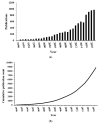A Bibliometric Review of Publications on Oxidative Stress and Chemobrain: 1990-2019
- PMID: 32443630
- PMCID: PMC7278845
- DOI: 10.3390/antiox9050439
A Bibliometric Review of Publications on Oxidative Stress and Chemobrain: 1990-2019
Abstract
Oxidative stress is considered one of the possible mechanisms behind chemobrain or the cognitive dysfunction persistent after chemotherapy treatment. Breast cancer patients have reported chemobrain symptoms since the 1990s. In this present bibliometric review, we employed the VOSviewer tool to describe the existing landscape on literature concerning oxidative stress, breast cancer chemotherapies, and chemobrain. As of 2019, 8799 papers were listed in the Web of Science database, with more than 900 papers published each year. As expected, terms relating to oxidative stress, mitochondria, breast cancer, and antioxidants have occurred very often in the literature throughout the years. In recent years, there has been an increase in the occurrence of terms related to nanomedicine. Only within the last decade do the keywords 'brain', 'blood-brain barrier', and 'central nervous system' appear, reflecting an increased interest in chemobrain. China has become the most prolific producer of oxidative stress and chemotherapy related papers in the last decade followed by the USA and India. In conclusion, the subject of oxidative stress as a mechanism behind chemotherapies' toxicities is an active area of research.
Keywords: antioxidants; chemobrain; chemotherapy; cognitive dysfunction; oxidative stress.
Conflict of interest statement
The authors declare no conflict of interest.
Figures





Similar articles
-
A Bibliometric Review of the Keap1/Nrf2 Pathway and its Related Antioxidant Compounds.Antioxidants (Basel). 2019 Sep 1;8(9):353. doi: 10.3390/antiox8090353. Antioxidants (Basel). 2019. PMID: 31480567 Free PMC article. Review.
-
A Bibliometric Analysis of Cyclophosphamide, Methotrexate, and Fluorouracil Breast Cancer Treatments: Implication for the Role of Inflammation in Cognitive Dysfunction.Front Mol Biosci. 2021 Aug 20;8:683389. doi: 10.3389/fmolb.2021.683389. eCollection 2021. Front Mol Biosci. 2021. PMID: 34490346 Free PMC article. Review.
-
Four decades of chemotherapy-induced cognitive dysfunction: comprehensive review of clinical, animal and in vitro studies, and insights of key initiating events.Arch Toxicol. 2022 Jan;96(1):11-78. doi: 10.1007/s00204-021-03171-4. Epub 2021 Nov 2. Arch Toxicol. 2022. PMID: 34725718 Review.
-
Bibliometric study of immunotherapy for hepatocellular carcinoma.Front Immunol. 2023 Aug 4;14:1210802. doi: 10.3389/fimmu.2023.1210802. eCollection 2023. Front Immunol. 2023. PMID: 37600802 Free PMC article. Review.
-
Potential of Natural Phenolic Compounds against Doxorubicin-Induced Chemobrain: Biological and Molecular Mechanisms Involved.Antioxidants (Basel). 2024 Apr 18;13(4):486. doi: 10.3390/antiox13040486. Antioxidants (Basel). 2024. PMID: 38671933 Free PMC article. Review.
Cited by
-
Toward better understanding and management of chemobrain: the potential utilities of the MemTrax memory test.BMC Womens Health. 2024 Jul 17;24(1):406. doi: 10.1186/s12905-024-03251-4. BMC Womens Health. 2024. PMID: 39020328 Free PMC article.
-
Integrated approach to reducing polypharmacy in older people: exploring the role of oxidative stress and antioxidant potential therapy.Redox Rep. 2024 Dec;29(1):2289740. doi: 10.1080/13510002.2023.2289740. Epub 2023 Dec 18. Redox Rep. 2024. PMID: 38108325 Free PMC article. Review.
-
Trends in the Research Into Immune Checkpoint Blockade by Anti-PD1/PDL1 Antibodies in Cancer Immunotherapy: A Bibliometric Study.Front Pharmacol. 2021 Aug 17;12:670900. doi: 10.3389/fphar.2021.670900. eCollection 2021. Front Pharmacol. 2021. PMID: 34489691 Free PMC article.
-
Research trends and prospects on brain metastasis from breast cancer: A bibliometric analysis.Front Oncol. 2023 Apr 5;13:1091249. doi: 10.3389/fonc.2023.1091249. eCollection 2023. Front Oncol. 2023. PMID: 37091185 Free PMC article.
-
Redox imbalance induced by docetaxel in the neuroblastoma SH-SY5Y cells: a study of docetaxel-induced neuronal damage.Redox Rep. 2021 Dec;26(1):18-28. doi: 10.1080/13510002.2021.1884802. Redox Rep. 2021. PMID: 33563132 Free PMC article.
References
Publication types
Grants and funding
LinkOut - more resources
Full Text Sources
Research Materials

